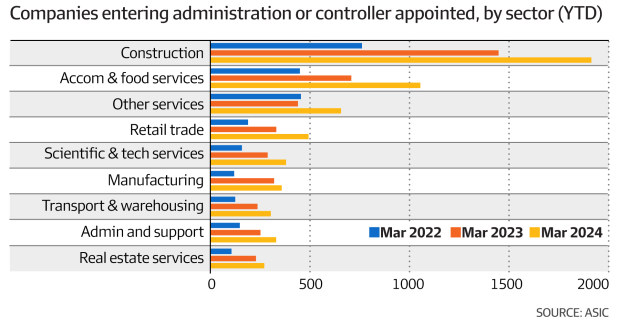The director of collapsed Canberra-based fitout and refurbishment business Rork Projects says a “tsunami of impossible economic conditions” is hitting the construction industry as the latest official figures point to a 32 per cent surge in insolvencies across the sector this financial year.
As of March 10, 1913 construction companies had entered administration or appointed a controller this financial year, nearly a third higher than the 1447 reported at the same time last financial year (which ended up at a decade high of 2213 for 2022-23) according to the latest ASIC update.
An office fitout that Rork Projects completed for Frasers in West End, Brisbane.
The number of construction industry failures is nearly double that of the next worst-performing sector, accommodation and food services, where a little more than 1000 businesses have collapsed this financial year. Nearly 500 retail businesses, including vacuum cleaner seller Godfreys, have folded since July 1 last year.
On Tuesday, creditors of Rork Projects, which undertook building fitouts and refurbishments for some of the country’s biggest landlords including Frasers, Cromwell, Stockland and Abacus, voted to liquidate the business as recommended by administrators from McGrathNicol. Rork Projects owed more than $25 million to creditors and had 63 projects under way when it collapsed a month ago.
Unsecured creditors, including subcontractors, tradies and suppliers who are owed a combined $15.1 million will probably get nothing back, administrators warn.
AdvertisementIn a statement explaining the reason for the group’s difficulties, Rork Projects director Brian O’Rourke said builders were “in crisis because of high interest rates, labour shortages and material supply constraints following the pandemic”.
“The construction market is facing one of the worst storms since the mid-1970 crisis. While devastating for us, it is also damaging to the Australian economy and community,” he said.
Denita Wawn, CEO of Master Builders Australia, pointed to a plethora of “significant difficulties” still confronting the construction industry, including “supply chain issues, fixed price contracts, low profit margins, labour shortages, inflation, higher interest rates, weather events and economic uncertainty”.
“While material prices are starting to stabilise, the industry is dealing with high labour costs and shortages, which are eating away at builder margins,” she said.
Ms Wawn said Master Builders and its members had been working closely with other industry participants to ensure there were builders and tradies available to pick up projects in the instance of insolvencies.
Builders hoping for a reduction in their monthly loan repayments might have to wait until November for the Reserve Bank to start cutting interest rates, economists warned this week.
Labour shortages are also likely to persist because of the immigration policies that exclude tradies from new fast-track visa rules and a 25 per cent drop in apprentices entering the industry, according to figures published by the National Centre for Vocational Education Research.
Founded in 1997, Rork Projects employed 77 staff and had offices in NSW, Victoria, Queensland and the ACT. The company made a $500,000 annual profit in FY21 off revenue of $71.6 million, but then reported losses of $4.3 million and $10.6 million in the next two financial years.
Growing losses
Losses continued to mount this financial year – despite cash injections from a related party entity and financial assistance from Commonwealth Bank – before administrators were appointed on March 1.
Preliminary investigations by administrators Mark Holland, Jamie Harris and Anthony Connelly indicate Rork Group may have been insolvent from at least June 30 last year “and possibly sooner”.
According to the administrators, the key reasons for Rork’s collapse include undertaking “several loss-making contracts” in the previous two financial years that pushed down gross margins, the “increasing rate of new project tenders being lost” and a “high overhead cost base ... not commensurate with the volume of revenue being won and delivered”.
According to company records, Rork had loss-making projects under way in Queensland, NSW and Victoria at the time of its collapse, including one in Victoria with a negative 26.7 per cent profit margin.
Although well over 2000 building companies are likely to have collapsed by the end of this financial year (based on the current rate of failures), there may be some light at the end of the tunnel – the failure rate appeared to peak in the September 2023 quarter.
There were 785 construction company collapses in that quarter (from July 1 to September 30), but 625 in the December quarter and 503 in the March quarter (to March 10).
“Over the 2023 calendar year, new business entrants to the construction industry outnumbered exits by over 9,100, so it is still proving to be a resilient and attractive sector,” Ms Wawn said.
Other builders to have collapsed in the past few months include 50-year-old Canberra-based Project Coordination, Melbourne-based Apex Homes Australia (now in liquidation) and the building arm of Sydney’s St Hilliers (for the second time).
- Forums
- ASX - By Stock
- Indices 01/04
The director of collapsed Canberra-based fitout and...
-
-
- There are more pages in this discussion • 59 more messages in this thread...
You’re viewing a single post only. To view the entire thread just sign in or Join Now (FREE)
Featured News
RNU
Renascor wins a funding boost given it wants to produce a critical mineral – but $5M award pales in comparison to some
TLX
Telix jumps 11.6% as US government indicates proposed medicare changes won't affect prostate cancer drug
Add XJO (ASX) to my watchlist
 (20min delay) (20min delay)
|
|||||
|
Last
7,959.3 |
Change
69.700(0.88%) |
Mkt cap ! n/a | |||
| Open | High | Low |
| 7,889.6 | 7,969.1 | 7,889.0 |
Featured News
| XJO (ASX) Chart |












